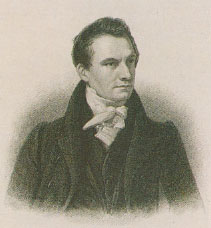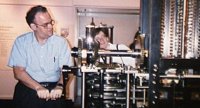 A brief biography of
Charles Babbage from Virginia Polytechnic's
History of Computing site.
A brief biography of
Charles Babbage from Virginia Polytechnic's
History of Computing site.
This page has links to information on Babbage and a few comments by Doron Swade on a proposal by Fowler in 1841 for a type of mechanical rod logic, a proposal of particular interest in light of more recent proposals by Drexler (see chapter 12 of Nanosystems) for nanomechanical computation which implement binary logic operations using molecular "rods."
It is interesting to contemplate the effect on history if Babbage had realized that a stored program computer could be made using relays. Such a computer could have been built in the 1800's, and would have advanced the use of the modern computer by almost a century.
 A brief biography of
Charles Babbage from Virginia Polytechnic's
History of Computing site.
A brief biography of
Charles Babbage from Virginia Polytechnic's
History of Computing site.
John Walker's site has many of the original articles describing the Analytical Engine, along with related material.
The Charles Babbage Institute (CBI) has a biography of Babbage.
The Babbage Pages from Exeter.
The Science Museum of London has a working model of the Difference Engine Number 2 on display.
Jonathan Bowen maintains a page on Babbage
Yahoo maintains a web page on Babbage.
A brief historical discussion of Babbage's Analytical Engine.
The chapter 'It will not slice a pineapple': Babbage, Miracles and Machines by Doron Swade (from reference 5, above) has a few paragraphs of particular interest with respect to rod logic:
Thomas Fowler, a self-taught Devonshire printer and bookseller, devised an original calculating device. Fowler had neither social position nor means. He was moreover humble and far from the bustling London social and scientific scene. In 1841 he wrote with touching vulnerability to George Biddell Airy, Astronomer Royal and de facto scientific advisor to government, about his hopes for exhibiting his machine at a forthcoming meeting of the British Association for the Advancement of Science.I have led a very retired life in this town without the advantage of any hints or assistance from anyone, and I should be lost amidst the crowd of learned and distinguished persons assembled at the meeting, without some kind of friend to take me by the hand and protect me.Fowler's machines were rendered in wood rather than metal. The machine was demonstrated in London and exhibited at King's College to some acclaim. Dignitaries of the mathematical establishment including Babbage, the astronomer Francis Baily and the logician Augustus De Morgan witnessed the device in action and confirmed its originality and efficiency. Fowler's machine differed in essential respects from Babbage's. Babbage's engines used the familiar decimal system with the numbers 0 through 9 each of which was represented by a discrete position of a rotating gear wheel. Fowler's machine on the other hand was more fully digital in that it used as its active element not rotating wheels but sliding rods which could occupy only one of three positions at any time. The advantage of reducing the number of distinct physical states is that parts can be made less precisely, and wooden devices by all accounts were practicable. In the light of Konrad Zuse's work in Germany on mechanial and electromechanical digital devices in the 1930s and 1940s, and the almost universal adoption of binary (two-state) digital techniques in the electronic computer age, Fowler's calculator was in certain respects vastly more promising than Babbage's. It is with unmistakable bitterness that Thomas Fowler's son wrote in a biographical notice following his father's death that 'the government of the day refused even to look at my father's machine, on the express ground that they had spent such large sums with no satisfactory result, on Babbage's "calculating engine"'. Bitterness is tempered by pathos when we learn that Fowler dictated details of his engine to his daughter on his deathbed. As with Babbage, the fate of innovation depended on vastly more than the promise or capability of the technology alone.The Fowler episode has come to light only recently and was unknown to Wilkes in 1971. (I [Doron Swade] found the Airy-Fowler correspondence in 1993.)
 Ralph Merkle turns the crank on Difference Engine No. 2 at
the British Museum of Science, London 1996.
Ralph Merkle turns the crank on Difference Engine No. 2 at
the British Museum of Science, London 1996.